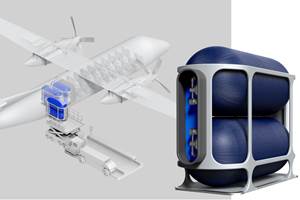Hitachi Power Solutions combines AI, drones to enhance wind turbine blade maintenance services
Blade Total Service follows maintenance service guidelines to ensure greater safety and security at wind power facilities when inspecting blades for repair.

Photo Credit: Hitachi Group
In April 2022, Hitachi Power Solutions (Ibaraki, Japan) says it is taking a big step forward to commence advanced services, titled “Blade Total Service” that mitigate the risks of wind power facilities — such as deterioration due to wear and tear of rotating blades, stress imposed by violent winds during typhoons and damage caused by lightning — by combining AI and other digital technologies with cutting-edge drone technology (also see “Mistras receives patent for Sensoria wind blade monitoring technology”).
Renewable energy is expected to become one of the prime power sources as Japan gears up to achieve carbon neutrality by 2050. Hitachi Power Solutions says it has constructed 461 wind power facilities since it entered the wind power business in 1996; it services more than 300 wind power facilities in Japan.
Yukihiro Shirahama, a maintenance service engineer of wind power facilities at Hitachi Power Solutions, stresses the importance of keeping rotating blades in proper maintenance. “While power is being generated, the tip of the blades rotates at a speed of 300 kilometers per hour, which makes it very vulnerable to damage,” Shirahama notes. “In fact, at various wind farms, there have been cases of dropped or broken wind turbine blades. We too have had such experiences at the facilities we service, in that we have encountered several instances of wind turbine blades being damaged by lightning strikes and typhoon winds.”
To address this shared concern, the Japan Wind Power Association (JWPA) in March 2021 established the “Wind Power Facilities – Rotating Blade Inspection and Repair Guidelines.” A member of the working group for compiling the guidelines, Hitachi Power Solutions, set out in fiscal year 2021 to develop a new maintenance service geared specifically towards the guidelines in a bid to ensure greater safety and security at wind power facilities.
The development team hopes to apply the maintenance service to offshore wind farms.
When going about designing Blade Total Service, Hitachi Power Solutions paid particular attention to advancing its maintenance services by integrating inspection using digital technology with maintenance planning and repair work. Hitachia joined forces with Sensyn Robotics Inc. (Tokyo, Japan), a provider of automatic, drone-based image capture, to further the guidelines’ developments.
“Using technology they [Sensyn Robotics] suggested, we used drones to inspect blades on site on a trial basis,” Shirahama recalls. “Within a couple of hours of arriving at the site for the first time, we were able to fly a drone automatically for inspection [a trial flight on a simplified route for wind turbines, inspecting one blade from two angles]. We had wind of 12 meters/second at that point. Up until then, we had assumed for some reason that drones were not suitable for inspecting wind power facilities, which are typically located in windy areas. Contrary to our assumption, however, we became confident that there was a good chance of using drones for facility inspection. Then, the project went into full swing from early June 2021.” Afterwards, while meeting with members of the development team five or six times, Shirahama repeated test demonstrations until a blade inspection system was completed.
One of the advantages of automatic, drone-based image capture, says Hitachi, is, first and foremost, shorter inspection time and higher work efficiency. In the past, service engineers have had to use a telephoto lens camera to shoot parts that looked damaged, from the ground, and then check the images afterwards. The drawback of this method, however, is it takes a fair amount of manual labor. Secondly, this system is said to help significantly increase inspection accuracy. Automatic image capture using drones enables the technician to capture images of the object from all angles and to take high-definition images head on and up close, with the result being that the extent of damage can be determined no matter where and when images are taken.
“Our goal for this project was to develop advanced services that cover everything from inspection to repair work.”
But why is maintenance planning so important? According to Hitachi Power Solutions, the pace of damage progression often differs depending on the timing and methods of repairs. The optimal maintenance plan can reduce the frequency and area of repair work. That is to say, owners of wind power facilities can minimize downtime, which in turn helps to sustain the amount of power produced, which is an added benefit to their business.
In addition, for this project, the company says it developed a data management system which sorts through and classifies the mounds of image data by wind farm or shooting angle. Applying digital data management to inspection, maintenance planning and repair work under a unified system improves work efficiency. Furthermore, amassing data on past damage and repair history also helps to enhance the effectiveness of maintenance planning.
Meanwhile, repair work benefits greatly from the use of drones for the inspection of wind turbine blades. A self-taught, experienced repair engineer, Naoya Kanazawa, explains: “When we use drones for automatic image capture, images are taken from the same position and angle every time. We suggested to Sensysn Robotics that we instead shoot images from five different angles. This is because it can sometimes be difficult to determine the extent of damage from images taken from the four traditional angles, along the X and Y axes, head on. Low accuracy in damage assessment can affect choices when it comes to repair work and repair techniques. Our goal for this project was to develop advanced services that cover everything from inspection to repair work, which should allow us to repair and maintain the blades in an optimal manner according to plan."
Ultimately, the roles and goals of Blade Total Service underpins the safe and secure operation of wind power facilities. “For one thing, we are thinking of further tapping into the strengths of the ‘OT [Operational Technology] x IT [Information Technology]’ formula,” Shirahama notes. “For example, we are hoping to accumulate more specific knowledge such as the tendency for certain types of damage to turbine blades, as well as tendencies in repair history in order to further optimize our maintenance service. Also, this new maintenance service can be applied to not just our facilities, but to facilities from many different suppliers as well, which should allow us to extensively contribute to the expansion of the wind power business in Japan.”
The development team hopes to apply the maintenance service to offshore wind farms by leveraging knowledge gained from projects that the Hitachi Group has been previously involved with. “For us to expand the use of renewable energy, we must ensure the safety and security of wind power facilities,” Shirahama concludes. “However small the contribution of our Blade Total Service might seem, we believe that well-planned maintenance of wind power facilities is fundamental in helping Japan to achieve carbon neutrality.”
Related Content
JEC World 2022, Part 3: Emphasizing emerging markets, thermoplastics and carbon fiber
CW editor-in-chief Jeff Sloan identifies companies exhibiting at JEC World 2022 that are advancing both materials and technologies for the growing AAM, hydrogen, automotive and sustainability markets.
Read MoreInfinite Composites: Type V tanks for space, hydrogen, automotive and more
After a decade of proving its linerless, weight-saving composite tanks with NASA and more than 30 aerospace companies, this CryoSphere pioneer is scaling for growth in commercial space and sustainable transportation on Earth.
Read MoreCarbon fiber in pressure vessels for hydrogen
The emerging H2 economy drives tank development for aircraft, ships and gas transport.
Read MoreMoving toward next-generation wind blade recycling
Suppliers, fabricators and OEMs across the composite wind blade supply chain ramp up existing technologies, develop better reclamation methods and design more recyclable wind blades.
Read MoreRead Next
Composites end markets: Energy (2024)
Composites are used widely in oil/gas, wind and other renewable energy applications. Despite market challenges, growth potential and innovation for composites continue.
Read MoreFrom the CW Archives: The tale of the thermoplastic cryotank
In 2006, guest columnist Bob Hartunian related the story of his efforts two decades prior, while at McDonnell Douglas, to develop a thermoplastic composite crytank for hydrogen storage. He learned a lot of lessons.
Read MoreCW’s 2024 Top Shops survey offers new approach to benchmarking
Respondents that complete the survey by April 30, 2024, have the chance to be recognized as an honoree.
Read More















.jpg;maxWidth=300;quality=90)














